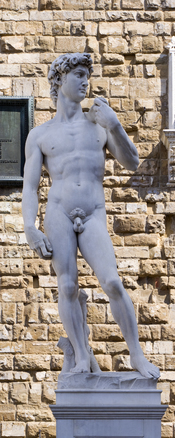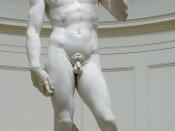The Four Davids
David, who was destined to be the second king of Israel, destroyed the Philistine giant Goliath with stone and a sling. Donatello, Verrocchio, Michelangelo, and Bernini each designed a sculpture of David. However, the sculptures are drastically different from one another. Each one is unique in its own certain way.
Donatello, whose David was the first life-size nude statue since Classical times, struck a balance between Classicism and the realism by presenting a very real image of an Italian peasant boy in the form of a Classical nude figure. Although Donatello was inspired by Classical figures, he did not choose a Greek youth in his prime as a model for his David. Instead, he chooses a barely developed adolescent boy whose arms appeared weak due to the lack of muscles. After defeating Goliath, whose head lies at David's feet, he rests his sword by his side, almost to heavy to handle.
It seems almost impossible that a young boy like David could have accomplished such a task. David himself seems skeptical of his deed as he glances down towards his body. Apparently, David's intellect, faith and courage made up for his lack of build (Fichner-Rathus 331-332).
Verrocchio, who also designed a sculpture of David, was the most important and imaginative sculptor of the mid-fifteenth century. This figure of the youthful David is one of the most beloved and famous works of its time. In Verrocchio's David, we see a strong contrast to Donatello's treatment of the same subject. Although both artists choose to portray David as an adolescent, Verrocchio's brave man "appears somewhat older and excludes pride and self-confidence rather than a dreamy gaze of disbelief" (Fichner-Rathus 334). Donatello balanced realistic elements with an idealized Classically inspired torso whereas Verrocchio's goal was absolutely realism in minute details.



The Four Davids
You've written an informative essay on how Donatello, Verrocchio, Michelangelo, and Bernini each designed sculptures of David which were drastically different from one another. Most people are probably aware that Michelangelo created a famous sculpture of David, but may not know that three other artists did likewise, while bringing their own unique perspectives to the work. Your report was well researched with a bibliography which nicely complemented the paper's internal citations. Your documentation will be helpful to those who wish to do further research on this topic. Good job!
9 out of 9 people found this comment useful.